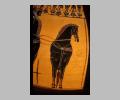| Collection: | Tampa Museum of Art |
| Summary: | Side A: quadriga and charioteer. Side B: warrior donning greaves, men and youths |
| Ware: | Attic Black Figure |
| Painter: | Attributed to the Swing Painter |
| Date: | ca. 540 BC - ca. 530 BC |
| Dimensions: | H. 0.395 m. |
| Primary Citation: | |
| Shape: | Amphora |
| Beazley Number: | 340552 |
| Period: | Archaic |
Decoration Description:
Side A: frontal quadriga, the horses' bodies foreshortened. All the horses have red manes and tails and red breast bands with white rosettes. The pole horses look toward one another, their faces overlapping. The trace horses look away to left and right. A red square is on the front of the chariot box. The charioteer with red hair and beard wears a long white chiton. He holds the reins and looks to the right.
Side B: nude warrior dons greaves flanked by a man and a youth on each side. The warrior has red hair and a red beard. On the ground below him rests a Corinthian helmet with a stilted white crest. Behind the warrior at left, a man gestures with his raised left hand. The man wears a himation with red stripes and white rosettes. Behind the man at far left stands a nude youth with red hair. His clenched fists are drawn up at his waist. In front of the warrior to the right stands a man with red hair and a red beard, wearing a himation with red stripes and white rosettes. At far right, walking right, is a nude youth holding a red staff in his left hand.
Above the scene on Side A is a lotus and palmette festoon. Above the scene on Side B is a band of lotus buds. There are two red stripes on the neck, on the edge of the mouth, below the scenes, and above the zone of rays on the lower body. There are single stripes around the mouth and lip, on the neck and on the foot.
Inscriptions:
Traces of a red dipinto now illegible on bottom of foot.
Collection History:
Tampa Museum of Art, Joseph Veach Noble Collection.





